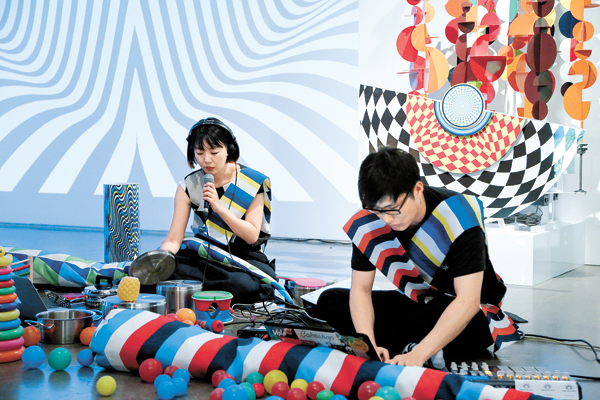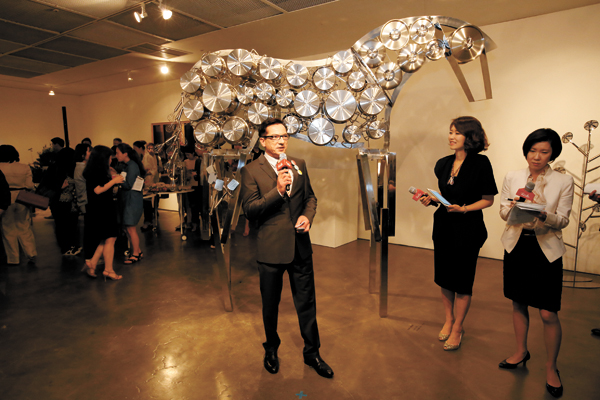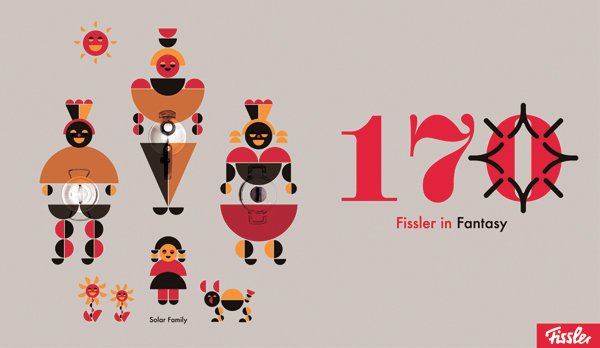Fissler Korea turns the modern kitchen into a creative space

The artist Vakki, left, took inspiration from Fissler’s iconic solar pattern to make this installation, entitled “Quantum Fluctuation Inside a Half Circle.” She explained her motivations behind the piece on June 1 at the Horim Art Center, southern Seoul. Provided by Fissler Korea
So in an effort to change women’s perceptions of the kitchen, Fissler, the 170-year-old German cookware company, has re-conceptualized the image of the modern kitchen. The idea is a simple one: The kitchen is a place to be inspired and let creativity flow.
To deliver that message to its consumers, the German cookware brand chose to do it through art. As part of its 170th anniversary, Fissler Korea held an art exhibition over 10 days, starting June 1 at the Horim Art Center in southern Seoul.
The company’s domestic branch has been especially active in supporting local artists and working with them to promote its brand.
Under the theme, “Kitchen in Fantasy,” 17 Korean artists were asked to produce a piece of art by interpreting the Fissler brand in their own language. The outcomes ranged from paintings and installations to photography and furniture.
The number of artists chosen was also intended to pay homage to Fissler Korea’s 17th anniversary.
“Our company is now 170 years old and we’ve proven over the decades that being in the kitchen is not just work,” said Fissler CEO Markus H. Kepka, who visited Korea early last month for the anniversary exhibition. “It’s a space of creativity and inspiration, and that’s the reason why Fissler very often collaborates with artists to show consumers how creative and how inspiring we can be in dealing with kitchen items and cookware. This is something [that allows] our customers to have a very close relationship [with the brand], and that is the reason why we, as a cookware company, exclusively conduct these kinds of art exhibitions.”
For the show, Korean photographer Youngho Kang printed photographs relating to the brand on 12 T-shirts, taking the idea from two words with the same pronunciation - “ware” in “cookware” and “wear,” as in “to wear a T-shirt.” For the project, Kang shot some of Fissler’s iconic products, as well as the face of Korean actress Kim Hye-soo, who modeled for the domestic brand in 2009, and printed them each on 12 T-shirts.
“While I was working on my piece for the exhibition, the television was turned on to this education channel that was broadcasting a documentary about the Medici family” who were a political dynasty in Italy during the 14th century, Kang said on June 1, during a media tour for the show at the Horim Art Center.

Fissler CEO Markus H. Kepka speaks during the opening ceremony of the company’s 170th anniversary exhibition in front of a horse installation made from Fissler pots. The piece, by Korean artist Park Jin-woo, is titled “Timeless.”
“What Fissler is doing with artists is somewhat similar to what the Medicis did [for the Italian Renaissance].”
“Because the House of Medici selflessly supported the arts and culture, valuable artworks were able to be [preserved and exhibited] in cities like Florence and Milan,” Kang said. “I can’t deny that this kind of project by a company has no publicity aspect behind it. But collaborating with artists while allowing them to maintain their true identities as artists and holding art exhibitions together like this - rather than exerting power over them - is a valuable opportunity and experience for us.
Other participating artists included photographer Kim Soo-kang, who captured one of the company’s best known items, rendering the image using a 19th-centuy photographic printing process known as gum bichromate.
Her piece, “Fissler Premium Solar,” a vintage-style photograph of Fissler’s signature pot, seemed more like a delicate sketch than a picture.
“My artwork seems to be the most classic-looking piece of all the others exhibited here,” she said during the tour. “After I was offered the project from Fissler, I went onto its website and came across a slogan about how Fissler emphasizes a harmony between traditionalism and modernism. That’s very similar to the technique I use, because I still use an analogue technique that’s very laborious and time-consuming.”
Meanwhile, the Verythings, a group of installation artists, put on display a real kitchen, where visitors could enjoy finger foods while listening to the collective’s “Cooking Pot Percussion,” in which they sampled common kitchen sounds and strung it into a tune.
According to the company, most of the 17 artists already had experience working with Fissler Korea, while a few were new to this year’s exhibition.
Kang had actively worked with Fissler Korea before, serving as the creative director for Fissler Korea’s advertising campaign that began in 2011 - a project that gained a lot of attention for kicking off the era of “art advertising” in Korea.
In the company’s latest television advertising campaign, entitled “Fissler in Fantasy - Inspiration Version,” Kang worked with the production company Matters in Liukh and actress Jun Ji-hyun.
In the commercial, Jun, dressed in a floor-length black dress, performs a modern dance routine across a dark empty room flooded by water and rain.

“Solar Family,” designed by Korean artist Esther Lee for Fissler’s 170th anniversary exhibition, uses the brand’s iconic solar pattern.
It is only at the end when “Fissler in Fantasy,” the company’s signature logo, flashes across the bottom of the screen.
To have none of the company’s products featured is a risky conceptual idea, equally as much as Fissler conducting art marketing, providing support to local artists. But the cookware company sees it as an investment, and its kitchens items as products “wanted,” rather than simply “bought.”
“For us, we never plan something to be a one-time shot [or merely] a PR event,” Kepka said. “We have a strong belief that as a company, like Fissler, we have to seek out a relationship with our consumers. That’s why we decided 10 years ago to build this emotional link. And the best way to bring people together emotionally is through art.
“That is the reason why, for more than 10 years, we have supported artists, as well as different kinds of creative activities which include collaborations with photographers, musicians and theaters,” he added.
But even though the exhibition’s run only lasted for 10 days, Fissler Korea said that most of the artists have and will continue to collaborate with the brand in various projects.
After taking a look around the show, Kepka expressed his amazement with the outcome of the event and hinted at the possibility that some of the artwork would be taken to Europe for the world’s largest housewares show, Ambiente, which starts in December.
“I couldn’t believe how creative the artists could be with the theme ‘Kitchen in Fantasy;” I’m very impressed,” he said. “I’m already thinking what we can take over to Europe. Once a year, there’s the world’s biggest housewares show, Ambiente, and I’m considering how I can integrate some of these things into our booth.”
Fissler’s luxurious line of pots and pans has a special place in the hearts of its Korean consumers, perhaps illustrated best in its historical connection.
In the decades following the 1950-53 Korean War, the central government sent thousands of people to work as nurses and miners in Germany as part of a guest worker program.
In their search for cookware during their stay, many of the workers encountered Fissler’s pressure cooker, introduced in the 1950s. Germans mostly used the product to steam potatoes and other vegetables, but for the Koreans, it was nothing short of amazing - the pressure cooker, they thought, made the rice taste even better than the rice cooked back home, where most South Koreans were using electric rice cookers.
As a result, many of the guest workers are said to have brought back Fissler pressure cookers as gifts for their families, which thereby solidified the company’s connection with Korea.
BY YIM SEUNG-HYE [yim.seunghye@joongang.co.kr]










with the Korea JoongAng Daily
To write comments, please log in to one of the accounts.
Standards Board Policy (0/250자)